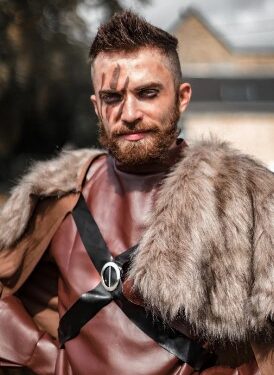The Viking Age lasted roughly from A.D. 800 to the 11th century. Although this is only a brief point in human history, it had a large impact on various aspects of our culture. In fact, Viking warrior designs are some of the most recognizable across the world.
Their influence has been the inspiration behind many tattoos, pieces of medieval jewelry, etc. Let’s explore Viking designs in detail below.
The Entertainment Industry
Vikings have been featured in a noteworthy number of video games, shows, and movies. Creators of these media have also used Viking culture as inspiration. One of the most prominent examples is Game of Thrones.
In the series, many characters, societies, and the format of the story itself have drawn from Viking history. In terms of more blatant references, there’s even a TV series called “Vikings.” Of course, we can’t forget the popular superhero Thor, who is based on the Norse god of the same name.
Jewelry
There’s no shortage of Viking-themed jewelry available across the world. This includes earrings, bracelets, rings, and necklaces with unique designs.
More often than not, these include spiritual or religious symbols. People often wear them as a form of protection from negativity or evil. Of course, there’s nothing wrong with wearing them as a fashion statement.
Very few Viking-themed pieces are made out of gold. Instead, the chosen material is often silver or stainless steel.
In Viking societies, men wore just as much jewelry as women did. They often did so as a way to showcase the rewards they achieved through battle. For example, it wasn’t uncommon for a strong Viking warrior to raid the coffers of a defeated village.
He would then adorn himself with jewelry he found appealing and wear it in future battles. When browsing Viking jewelry, it’s best to choose a high-quality supplier.
This will help ensure you get a product that’s worth your money. You can purchase Viking necklaces here.
Skiing
Many people find it interesting that Vikings played a significant role in the popularization of skis. Due to the snowy climate in which they lived, transporting goods or traveling quickly was notably difficult.
To remedy this, Vikings used skis to traverse the snow-covered landscape. However, they also skied for recreation.
Similar to society today, races and competitions were fairly common. Some of the deities of Norse mythology (namely Ullr and Skaoi) were even depicted using snowshoes or skis.
Combs
In media, Vikings are often portrayed as rugged but well-groomed warriors. Their beards and hair are surprisingly well-kempt despite the time period.
The truth is that this is historically accurate. Vikings often used combs on a regular basis to keep their hair and beards free of tangles and knots.
They even used razors and tweezers. Some historians credit Vikings with inventing the modern comb. In addition to grooming themselves regularly, they also bathed fairly often for that point in history.
At least once per week, they would visit a hot spring to wash away dirt, sweat, and grime. In comparison, people in many other European societies bathed far less often.
Fur Clothing
Vikings weren’t the first people in history to wear fur clothing. However, they can be considered one of the main civilizations that popularized it.
Vikings wore fur simply as protection from the elements. They fashioned coats and garbs out of the animals they hunted, such as boar, elk, and bear.
Their fur clothing combined with their rugged appearance made for a unique aesthetic. Since Vikings depicted in media are often outfitted in fur, this aspect of their culture has spread to modern society.
Trade Routes
Many of the trade routes Vikings navigated are still used today. These covered large areas in Europe, Russia, China, and the Middle East. Without these routes, it would have been difficult for Viking societies to thrive.
The trade routes they used allowed many countries to participate in the international market during that time. Although it’s likely another society would have mapped out the same trade routes, we have the Vikings to think for laying the foundation.
Dublin, Ireland
Believe it or not, the city of Dublin was founded by Vikings. The city was created to serve as a hub for the location where Vikings kept their ships. After a few hundred years, the local Irish rebelled against Viking rule and overtook the city.
Other Irish cities that used to belong to the Vikings include Limerick, Waterford, and Wexford. Today, Dublin still retains a bit of its Viking history.
Certain locations throughout the city memorialize the previous Viking occupation. The same can be said about its local history museums.
The Appeal of Viking Culture
It’s no secret that Viking societies were some of the most unique in history. This is one of the main reasons why they’re so appealing. There’s something alluring about large, strong warriors who had flowing locks and full beards.
They were also known for being diligent and aggressive in battle. In Viking society, it was seen as better to die fighting than to come back alive. Obviously, emerging victorious would be ideal, but Vikings would stay and fight to the death even if they were outnumbered or outmatched.
Don’t Overlook Viking Warrior Designs
Viking warrior designs are some of the most noteworthy throughout all of history. With a bit of effort, it’s not difficult to notice their influence on modern society.
Our blog has plenty of other lifestyle articles that you can learn from. Be sure to check them out today!

